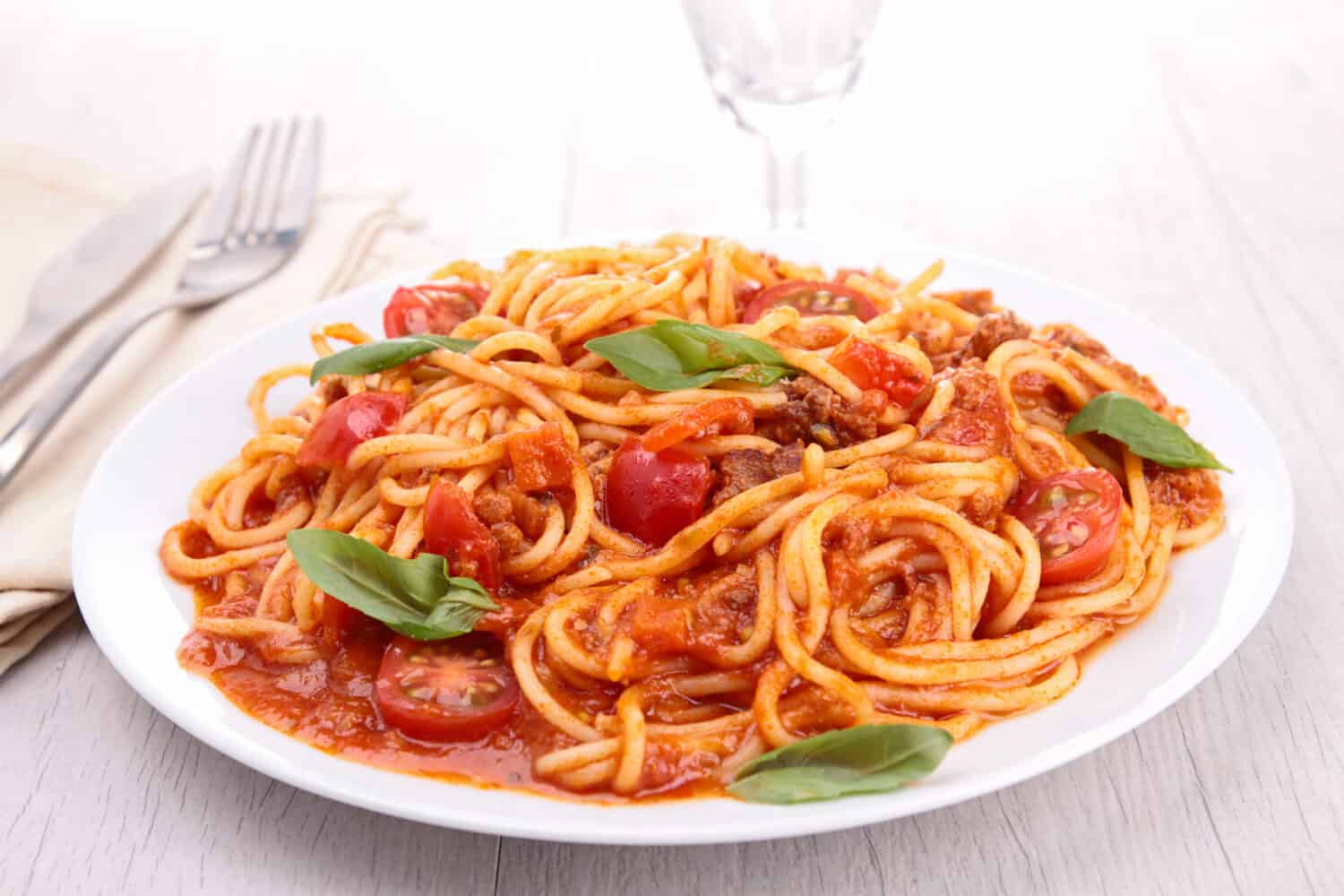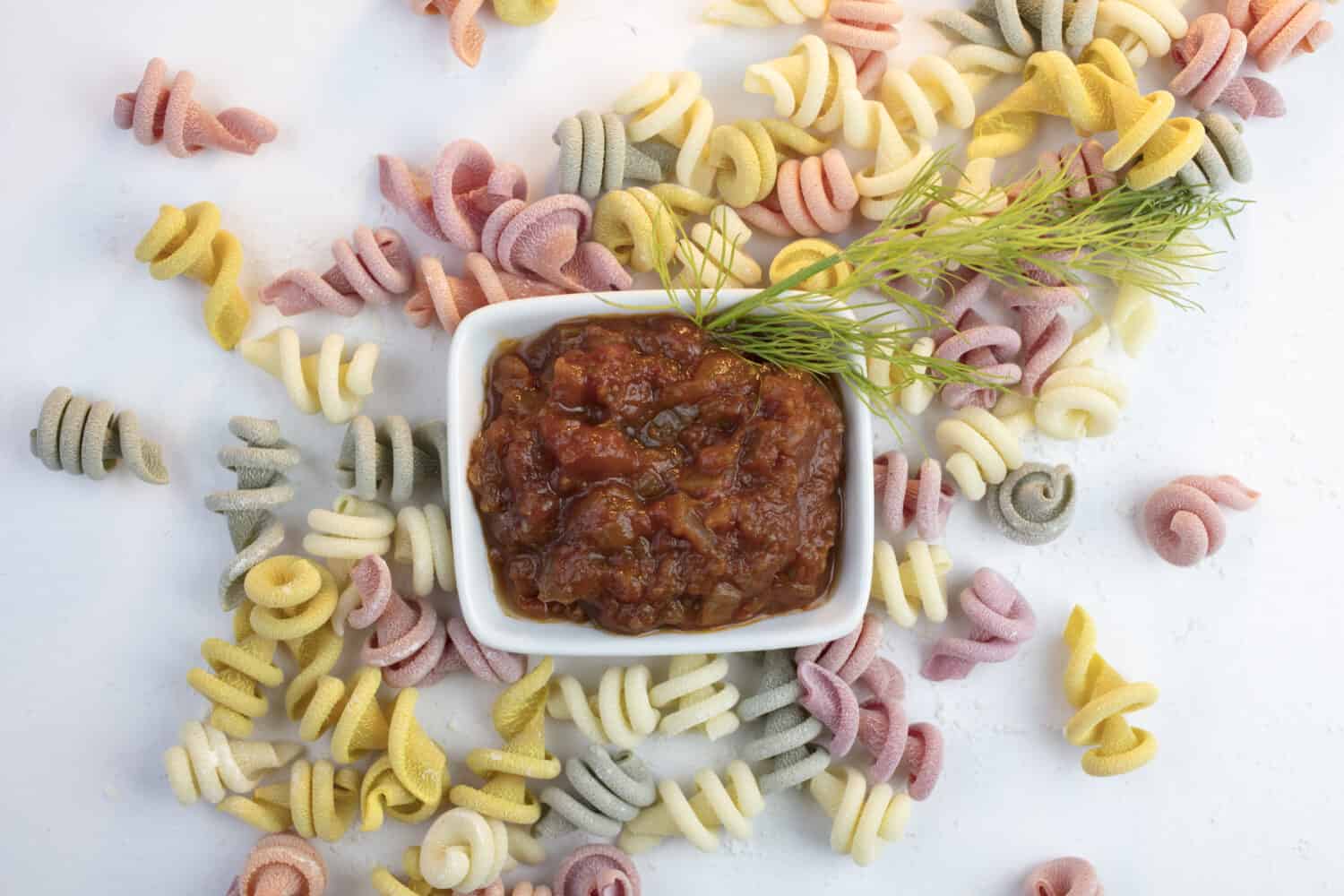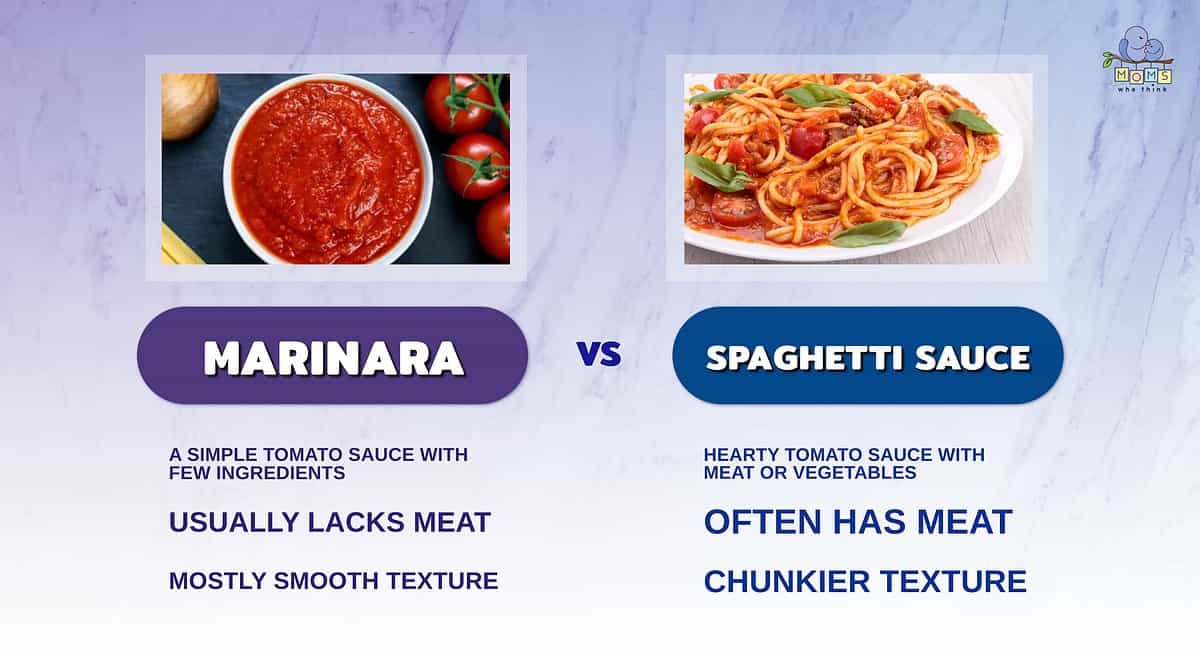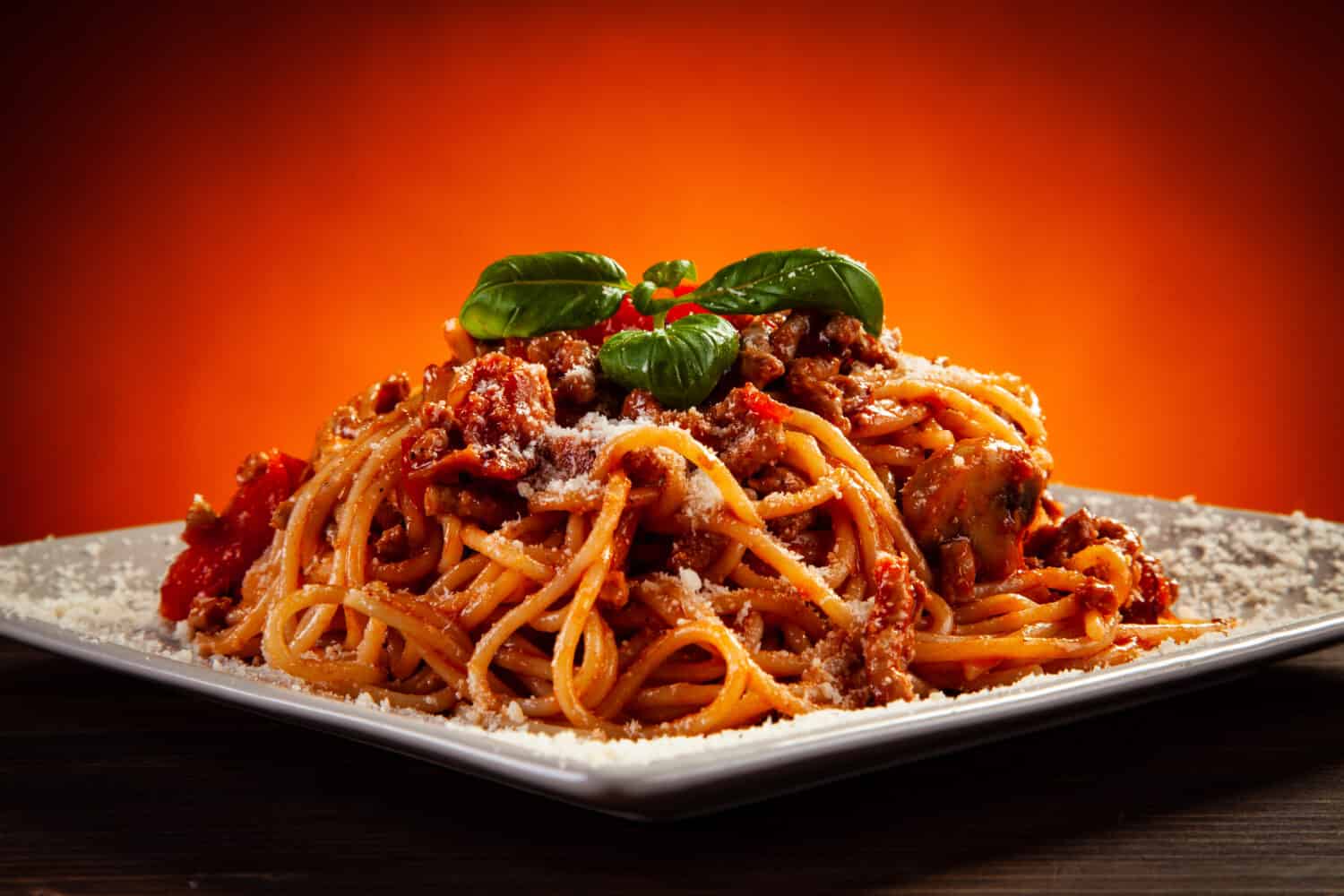Spaghetti sauce usually contains meat, which is the main difference between spaghetti sauce and marinara sauce. However, spaghetti sauce is usually much thicker than marinara sauce. It must be said, however, that it can be difficult to distinguish the differences between the two.
If you've ever wondered what the difference is between marinara sauce vs. spaghetti sauce, you're not alone. Even though these two sauces seem similar and are often used interchangeably, there are some notable differences that set them apart.

©Chatham172/Shutterstock.com
Marinara vs. Spaghetti Sauce: What is the Difference?
When it comes to making Italian dishes, marinara, and spaghetti sauce are two of the most commonly used ingredients. While they may seem interchangeable, they each have unique qualities that set them apart. Marinara sauce is a simple sauce made from tomatoes, garlic, and herbs that are often used as a base for pasta dishes. Spaghetti sauce is a heartier sauce that usually includes meat, onions, and other vegetables. Understanding the differences between these two sauces can help you choose the right one for your recipe and take your Italian dishes to the next level. In this article, we will explore the key differences between marinara and spaghetti sauce, including their ingredients, cooking methods, texture, best uses, popular variations, nutrition comparison, and much more.
Origins of Marinara and Spaghetti Sauce
Marinara sauce originated in Naples, Italy, and was typically served with fish dishes in the mid-16th century. The name “marinara” actually comes from the Italian word marinaro, which means “sailor.” It's said that the Neapolitan sailors prepared this sauce at sea from whatever ingredients they had on hand.
Spaghetti sauce, on the other hand, has a more American origin. It's believed to have been developed by Italian immigrants who added meat to their marinara sauce to make it heartier and more filling for their families. Tomato sauce, tomato paste, diced or crushed tomatoes, and a number of spices are all ingredients in spaghetti sauce.
- The must-have convenient reference guide for every home cook!
- Includes more than 8,000 substitutions for ingredients, cookware, and techniques.
- Save time and money on by avoiding trips to grab that "missing" ingredient you don't really need.
Francesco Leonardi, a Roman cook who lived in the late 1700s, invented the first spaghetti sauce. In 1790, he published a recipe for his Italian tomato sauce in the L'Apicio Moderno cookbook. Francesco had unknowingly discovered culinary treasure.

©Toasted Pictures/Shutterstock.com
Ingredients That Differentiate Marinara and Spaghetti Sauce
Let’s compare.
Key Ingredients in Marinara Sauce
Prepared with only a few simple ingredients marinara sauce contains tomatoes, garlic, onions, olive oil, and herbs (usually basil, oregano, and thyme). Some recipes also include red bell pepper flakes to give the sauce a bit of a kick.
Key Ingredients in Spaghetti Sauce
Spaghetti sauce contains ground meat (often beef, pork, or a combination of the two). Additional typical ingredients include onions, garlic, celery, carrots, and canned tomatoes or tomato paste.
Herbs and Spices Used in Marinara and Spaghetti Sauce
Both marinara and spaghetti sauce usually contain basil, oregano, and thyme for flavor. However, spaghetti sauce may include spices such as bay leaves, fennel seeds, and rosemary.
Cooking Methods for Marinara and Spaghetti Sauce
Let’s compare.
Preparation Steps for Marinara Sauce
Start by sautéing the garlic and onion in olive oil. Next, add whole or crushed tomato and herbs, then simmer for about 20 minutes to allow the flavors to combine.
Preparation Steps for Spaghetti Sauce
Begin by browning the ground beef in a large pot over medium heat in olive oil. Next, add the chopped onion, celery, and carrot and cook until tender. Then add the garlic, tomatoes or tomato paste, herbs, and spices and simmer for at least an hour to allow the flavors to combine.
Cooking Techniques for Marinara and Spaghetti Sauce
The main difference in cooking technique between marinara vs. spaghetti sauce is cooking time. Marinara sauce usually simmers for about 20 minutes to develop flavors. In contrast, spaghetti sauce is simmered for at least an hour to allow the meat to fully cook and the flavors to meld.
Texture and Consistency of Marinara and Spaghetti Sauce
Marinara sauce has a smooth texture, with chunks of tomato and herbs. Spaghetti sauce has a chunkier texture, with pieces of ground meat, vegetables, and tomato present.
Consistency Differences Between Marinara and Spaghetti Sauce
Marinara sauce tends to be thinner and smoother. Spaghetti sauce is thicker and heartier because of the added meat and vegetables. However, you can adjust the consistency of both sauces to your personal preference by adjusting the cooking time and the amount of liquid used.
Classic Dishes
Italian pasta dishes such as spaghetti marinara, pizza, and lasagna use marinara sauce. Marinara is a popular dipping sauce for breadsticks, mozzarella sticks, and other appetizers.
Classic Italian-American dishes such as spaghetti and meatballs, baked ziti, and stuffed shells use spaghetti sauce. It is also great in casseroles, for meatloaf, and as a topping for roasted potatoes. For a vegetarian spaghetti sauce add mushrooms, eggplant, and zucchini to replace the meat add tofu for added protein.
Nutritional Values Between Marinara vs. Spaghetti Sauce
In the table below we will compare the nutritional values of marinara vs. spaghetti sauce with meat for a single serving size of (425g).
| Marinara Sauce | Spaghetti Sauce | |
|---|---|---|
| Calories | 99 | 460 |
| Total Fat | 7.5g | 5g |
| Saturated Fat | 1.1g | 1g |
| Trans Fat | 0g | 0g |
| Polyunsaturated Fat | 1g | – |
| Monounsaturated Fat | 5.1g | – |
| Cholesterol | 0mg | 10mg |
| Sodium | 228.8mg | 1060mg |
| Total Carbohydrate | 8.6g | 84g |
| Dietary Fiber | 4.2g | 6g |
| Sugars | 5.5g | – |
| Protein | 1.8g | 17g |
Conclusion and Final Thoughts on Marinara and Spaghetti Sauce

- Marinara sauce is a simple tomato sauce with few ingredients, while spaghetti sauce tends to be heartier with extra ingredients.
- Spaghetti sauce often has meat in it, making certain iterations of it unsuitable for vegetarians. Marinara sauce, on the other hand, is good for vegetarians due to its lack of meat. You can likely find vegetarian spaghetti sauce in the store, or make it yourself.
- Marinara has a mostly smooth texture with some chunk, while spaghetti sauce is much chunkier. This is due in part to the presence of meat or vegetables in spaghetti sauce.
In conclusion, marinara and spaghetti sauce are tomato-based, and marinara sauce is a simpler recipe that typically does not include additional vegetables or meat. Spaghetti sauce, on the other hand, often includes meat and additional vegetables for added flavor. Compared to spaghetti sauce with meat, marinara sauce is typically lower in calories, carbohydrates, and sodium.
While both may seem similar at first glance, they each have unique qualities. Whether you're a beginner or a seasoned chef, understanding the differences between these two sauces will help you create delicious Italian dishes that your family and friends will love.
- The must-have convenient reference guide for every home cook!
- Includes more than 8,000 substitutions for ingredients, cookware, and techniques.
- Save time and money on by avoiding trips to grab that "missing" ingredient you don't really need.
Tips for Choosing and Cooking with Marinara and Spaghetti Sauce
Make sure the marinara or spaghetti sauce you choose is low in sodium and sugar. For extra flavor and nutrition, add bell peppers, onions, and mushrooms when cooking. Try experimenting with these sauces in the kitchen!
FAQ
Can I use marinara sauce instead of spaghetti sauce?
Yes, you can use marinara sauce instead of spaghetti sauce in most recipes. However, keep in mind that marinara sauce has a thinner consistency and less complex flavor than spaghetti sauce, so you may need to adjust your recipe accordingly.
Is marinara sauce healthier than spaghetti sauce?
Marinara sauce is generally considered to be healthier than spaghetti sauce because it contains fewer calories and less fat. However, this can vary depending on the brands and recipes you use, so it's always a good idea to check the nutrition labels.
Are there any vegetarian variations of spaghetti sauce?
Yes, there are many vegetarian variations of spaghetti sauce that use vegetables like mushrooms, zucchini, and eggplant instead of meat. You can also use plant-based protein sources like tofu or tempeh in place of meat.
Can I freeze marinara and spaghetti sauce?
Yes, both marinara and spaghetti sauce can be frozen in an airtight container or freezer bag for up to 3 months. Just be sure to thaw them in the fridge before reheating.
Fancy something new for dinner tonight try these quick, easy, and delicious recipes:
Print
Butternut Squash, Chard, and Spinach Lasagna
- Yield: Serves 10 1x
Ingredients
1 (2 pound) butternut squash
Salt and pepper to taste
1 tablespoon olive oil, divided
2 cloves garlic, minced
1 shallot
8 ounces baby spinach leaves, washed, drained, but left damp
1 container (16 ounces) part-skim ricotta
1/2 cup shredded Parmesan
1 teaspoon dried oregano
1 teaspoon nutmeg
1 teaspoon ground cinnamon
1 bunch red chard, washed, drained, but left damp
1 jar (28 ounces) spicy marinara sauce
8 uncooked whole-wheat lasagna noodles
1 1/2 cups shredded mozzarella
Instructions
1. Chop the shallot. Remove stems from chard and coarsely chop.
2. With a knife or fork, poke holes or small slits all over squash. Place on a microwave-safe plate and microwave on high for 5 to 6 minutes or until a knife inserts easily into the skin.
Nutrition
- Calories: 434
- Sodium: 651mg
- Fat: 13g
- Carbohydrates: 67g
- Fiber: 10g
- Protein: 22g
- Cholesterol: 31mg
The image featured at the top of this post is ©Chatham172/Shutterstock.com.
- The must-have convenient reference guide for every home cook!
- Includes more than 8,000 substitutions for ingredients, cookware, and techniques.
- Save time and money on by avoiding trips to grab that "missing" ingredient you don't really need.


